Back to top: Overviw of Unit J1
The pertinent areas
JP is the main area to which unit J1 belongs. It includes the terrace and the plaza to the south and west of it, forming the big sacral complex in use from the moment of its construction during the ED III, almost until the abandonment of the site in the Late Mittani period. The Sacral complex did not undergo any large structural changes, except in the very last period of its use.
Back to top: Overviw of Unit J1
Location
Unit J1 is located to the south of the Revetment Wall, in its western portion. To the west it is adjacent to unit J5 opened in 2008 and including now the western part of J1, that was excavated during the 2006 season. To the east there is unit J3, excavated on the terrace to the north of the Revetment Wall. Unit J3 was excavated to check the construction technique of the Revetment Wall and its western face, while J5 was open to investigate the shape of the Revetment Wall and the possible presence of a western monumental staircase.
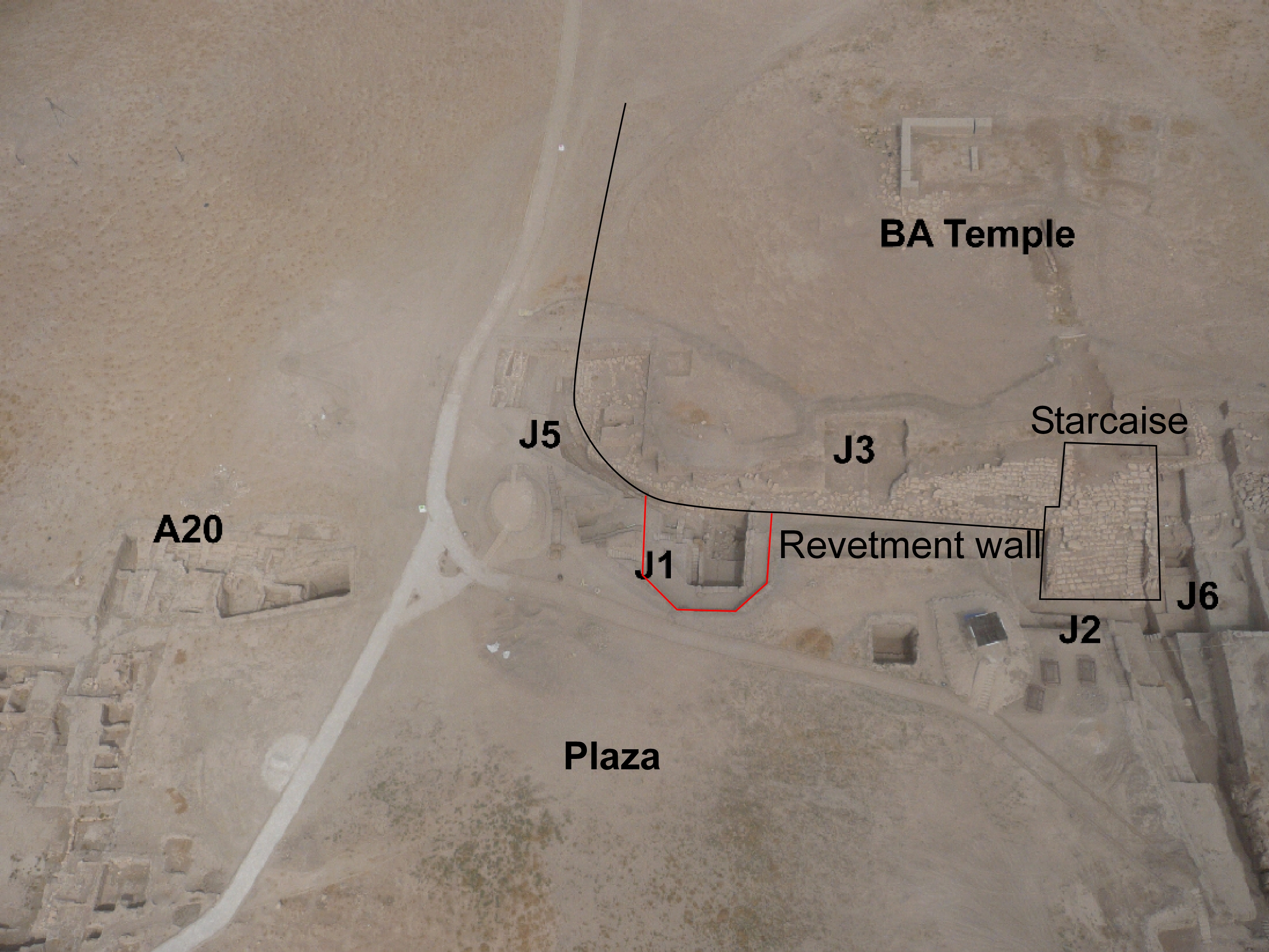
Back to top: Overviw of Unit J1
Phases
Phase 2i. Few possible structures (f356) identified below the northern wall of ^str1 probably belonging to a pre- LC terrace phase. Just a small sounding and more excavation is required.
Phase 2m. ^str1, the stone structure formed by two bonded stone walls, likely used for a Late Chalcolithic terrace, not yet clearly identified, but quite surely assumable.
Phase 3f. Different layers of Ninevite 5 accumulations found in three different spots of J1: to the south portion of J1, linked probably with the last use of the LC original terrace, before the major rebuilding of the ED III; to the west linked to episodes of erosion and refilling of the area.
Phase 3m. The construction of the revetment wall wall1 and its first escarpment^esc1.
Phase 3n.Water damage (erosion) of first escarpment, happened slightly after the original construction of ED III terrace complex. Following ashy accumulations.
Phase 3p. Cut out of erosion and construction of second large escarpment.
Phase 3s. Use of the second escarpment and construction of pavement, ^pav2.
Phase 3u. Erosion to the surface of second escarpment.
Phases 4-6. No evidences dating to this period have been found so far in J1 even though the city of Urkesh was a flourishing center during this time period. This is explained with a great care for this open space due to its great sacral importance, traduced in a continuous cleaning of the area (see topic.)
Phase 7c-Phase 7f. First Mittani use of EDIII pavement (^pav1) and accumulations (acc4) covering the ED III levels, first Mittani pavement (^pav2) and first curtain wall (^curt1), semi-natural accumulations abutting the base of revetment wall (^acc1).
Phase 7m-Phase 7v. Mittani accumulations (^acc2 and ^acc3) covering the revetment wall until it was completely covered. Last use of the Terrace with its sacral meaning.
Phase 8m. Limited occupation with few structures at the very top of the wall, during the Middle Assyrian period.
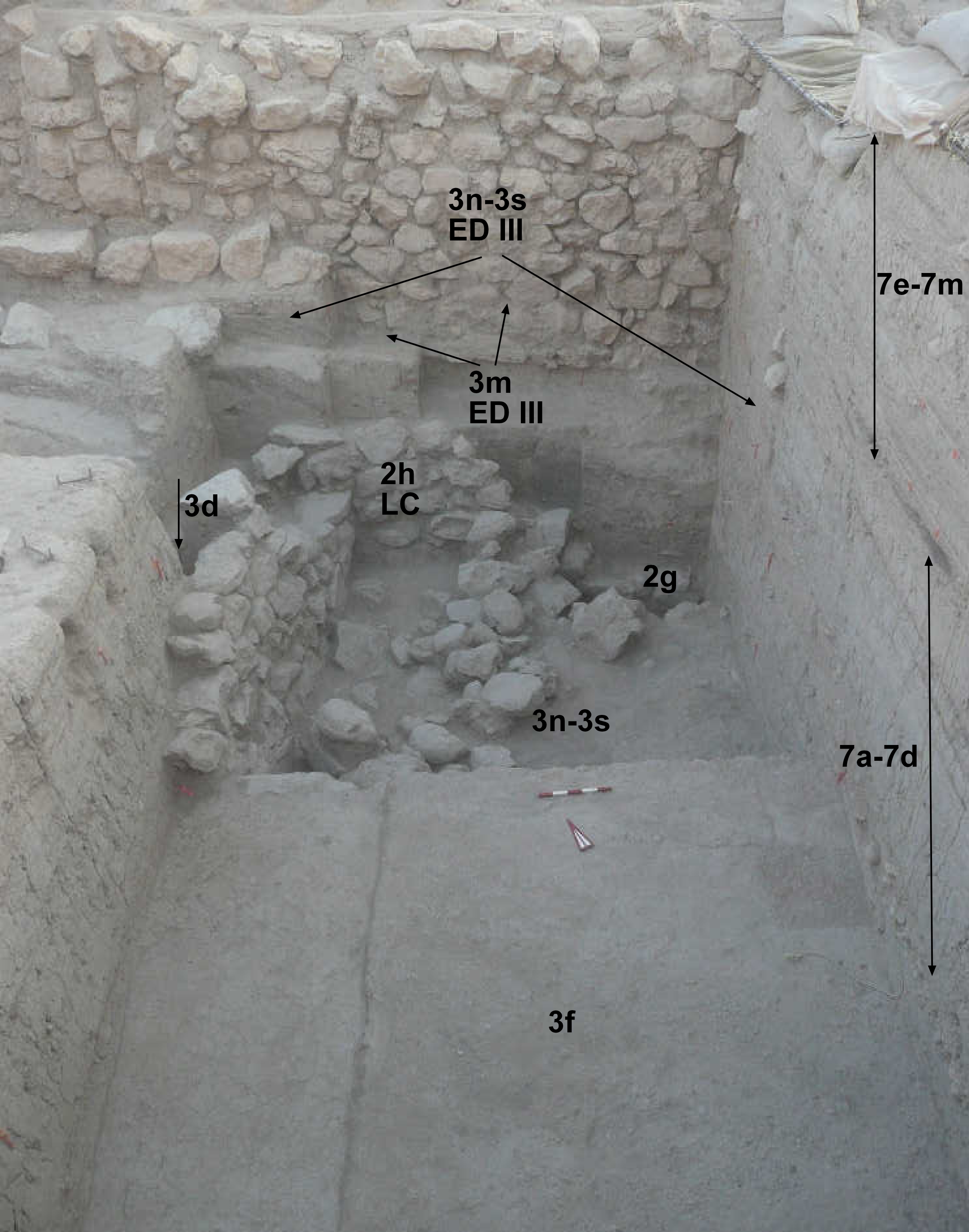
Back to top: Overviw of Unit J1
Physiognomy
The physiognomy of J1 is defined by the particular context of the area, an open space linked to the sacral use of the temple terrace and so also for the specific kind of accumulations.
Back to top: Overviw of Unit J1
Mittani Accumulations
Before the excavation of J1 the general idea was that during the Mittani period the city of Urkesh was really reduced in its importance and dimensions. During the last seasons our knowledge is much changed and this is due to the recovery of 3-4 meters of accumulations) in J1, many different architectural levels in Area AA (see A19 and A20) and the western monumental staircase in J5. The J1 accumulations are semi natural deposits that started to fill the Plaza when its southern edge was likely closed by some building of the Early Mittani. After the plaza was filled, started the abandonment of the site.
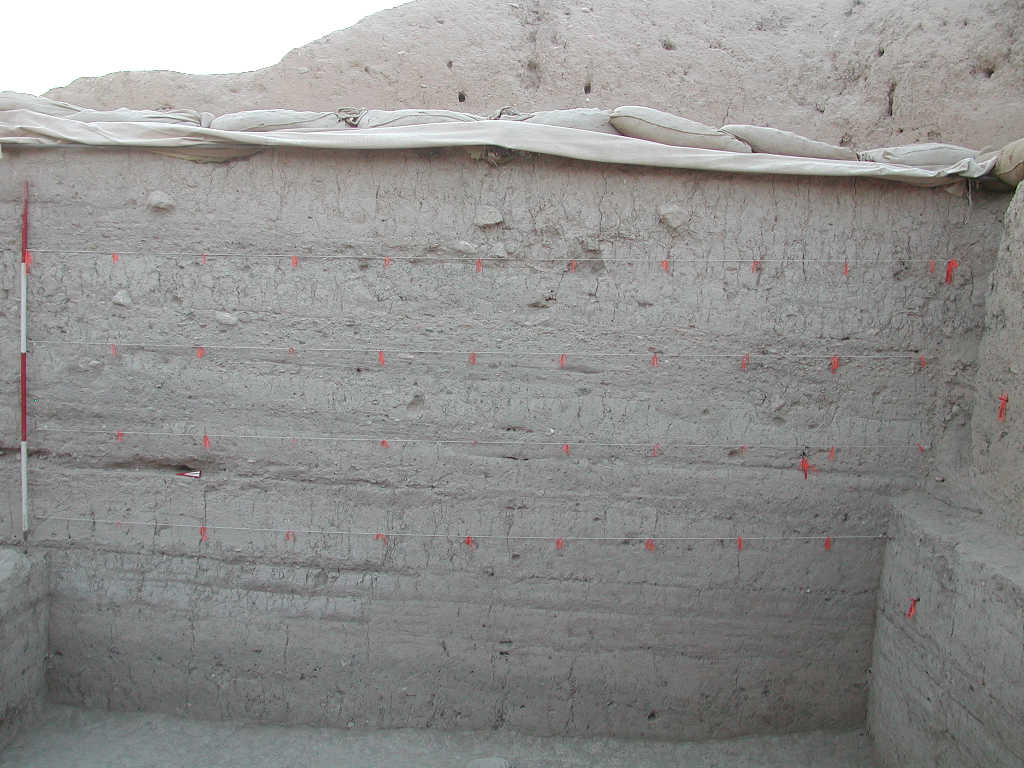
Back to top: Overviw of Unit J1
Revetment wall and its escarpments
One of the main goal of the first excavation in J1 was to uncover the face of the revetment wall f72 and to reach its bottom. It was not reached the first season, but just during the second one.
- The new discovery was that the wall was only three meters high instead of the supposed 5 meters, and that at its base there was a glacis (called “escarpment”) linking the difference in elevation between the base of the wall and the lower level of the plaza. The escarpment acted too as a protection for the base of the wall.
- Next goal was to reach the level of the plaza, but during this attempt many other questions were opened. And a better understanding of this area have been reached just in the last two seasons with a wider exposure of the stratigraphy below the Mittani accumulations.
- One of the most important discoveries of the last two seasons was the recovery of two different escarpments ^esc1 and ^esc2, one on top of the other, showing an intense use and care for this important sector at the base of the terrace.
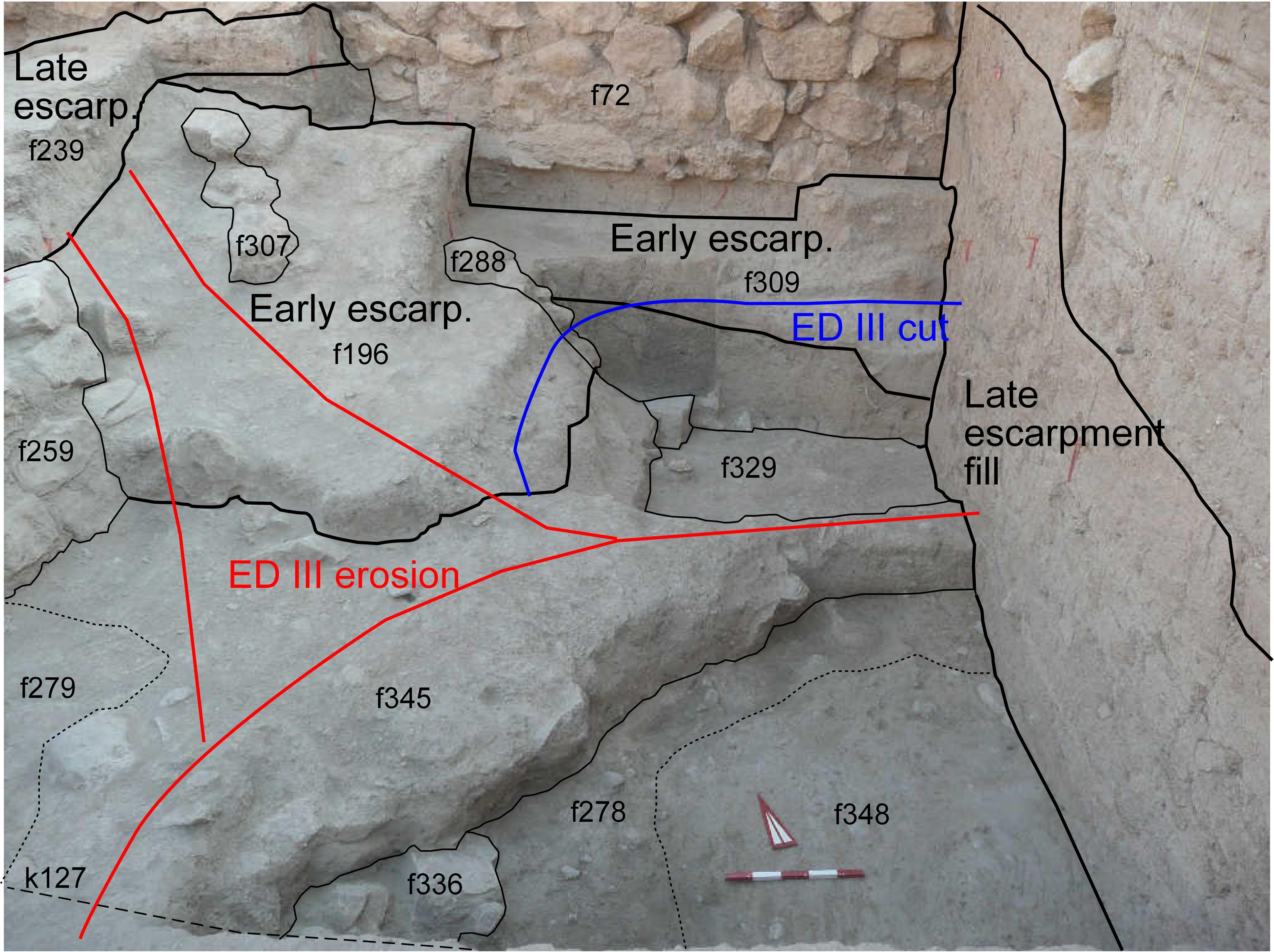
- The presence of Mittani accumulations abutting directly the ED III structures and Ninevite 5 materials shows an intensive cleaning of the area for more than I millennium.
- In the last seasons we dealt with a new problem: the water flowing causing a massive erosion that created many problems already in the antiquity.
- The recovery of an earlier structure, already in 2008, and clarified by the 2009 excavation.
Back to top: Overviw of Unit J1
Water problems and solutions
After 2009 excavation we realized that the water erosion was a big problem in the ancient time as today. It is in fact very likely that the reconstruction of the escarpment after a short period of time was due to the massive water damage that eroded deeply the surface of the Early escarpment. The water was probably coming from West where the tell, already in earlier period was at an higher elevation. The erosion, that probably did not affect the western portion where the base of the ED III wall was protected by a stone escarpment (J5), forced them to find a solution, i.e. an almost complete rebuilding of a new escarpment, much higher than the previous one, to protect the base of the revetment wall. This escarpment was excavated during the last season and it appears very irregular and damaged. We could hypothesize that in origin it was much more regular and with a more compact surface. The stone escarpment and the two clay escarpments, and the stone installations f307, were possible attempts to divert the water from the plaza and the base of the EDIII revetment wall.
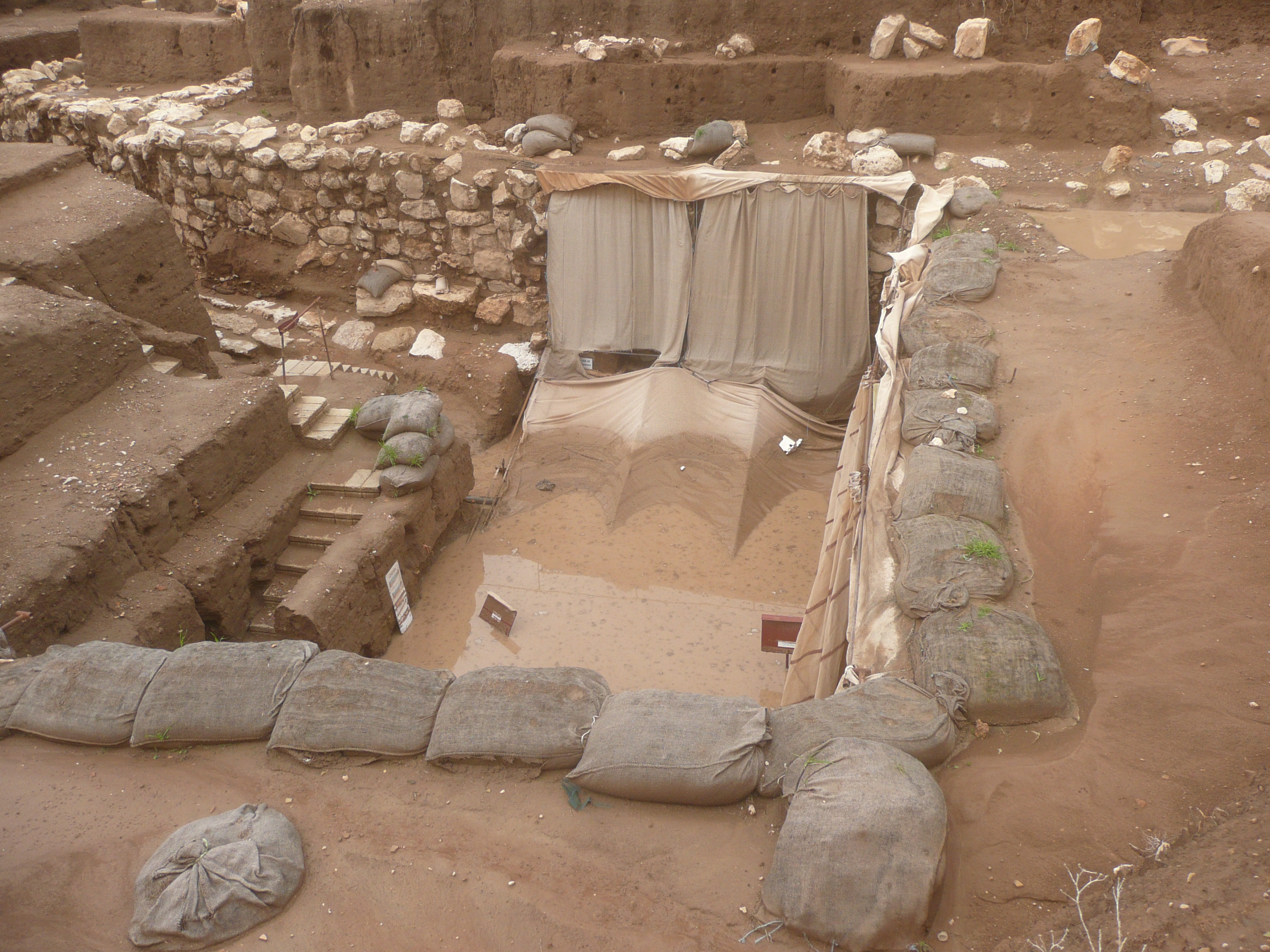
During Mittani period the escarpment was damaged and was surrounded from a low wall (^curt1). Some attempts to stop the erosion and the accumulation of water in the Plaza could be also seen in the big stones f328 forming a sort of water barrier. Several shallow water channel have been found running parallel to the wall in the later accumulation. The winters were very rainy, as shown by the picture of the results of a strong storm during march 2010, and a lot of water could fill the plaza and damage the structures.
Back to top: Overviw of Unit J1
Excavation in 2005-2007
After the small sounding carried on in the 2003 season the main excavation started in the 2005. During the first three seasons of J1 excavation, the orientation of the loci changed compared to the previous year, matching the alignment of the sitewide grid. Then, in a second moment, because of the kind of excavated stratigraphy of deep semi-natural accumulations, the area was shaped as a sort of amphitheater for safety reasons, creating the new loci k108, k109 and k110. Many other loci were created during the excavation of J1 not following the normal grid (k101-k120) because the amphitheater area has many temporary steps, sometimes in a second moment removed or reshaped. During 2006 the J1 excavation was enlarged to the west looking for the turn of the revetment wall. Today this area is included in J5 unit. The 2005 and 2006 seasons removed almost only the already mentioned Mittani semi-natural accumulations, reaching the ED III structure just in a small spot at the base of the revetment wall. In 2007 the excavation was very reduced in size and carried on just in k103 and k117 and investigated the levels right on top of the ED III escarpment.
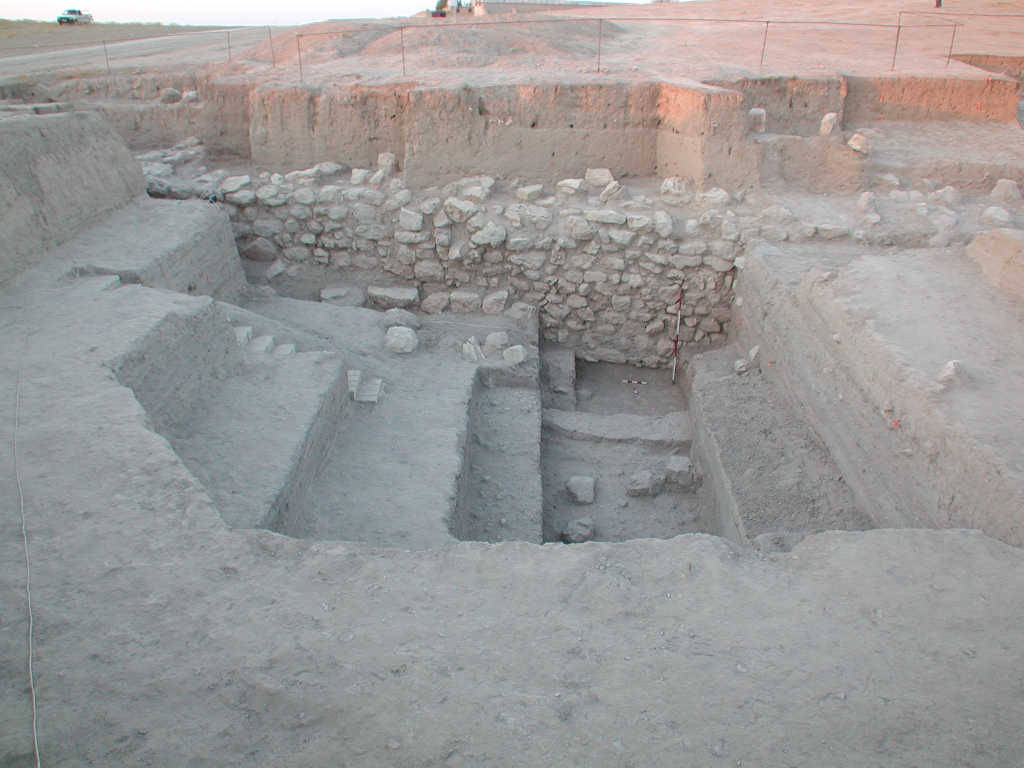
Back to top: Overviw of Unit J1
Excavation in 2008
The 2008 season changed completely the picture of J1 area. Many loci were excavated (k121-k128), some were just removed steps to regularize and enlarge the excavation area. In other loci like k126 and k127, the main excavation was carried out. Moreover at the end of the season was excavated the small sounding k128 that uncovered the stones that later will turn out being the east-west wall f288. The excavation regarded mainly k126, were just below the early Mittani accumulations and pavement were uncovered Ninevite 5 accumulations. The other locus k127 shows a more complex situation with a lot of different features belonging to ED III, that now we know to be part of the second escarpment.
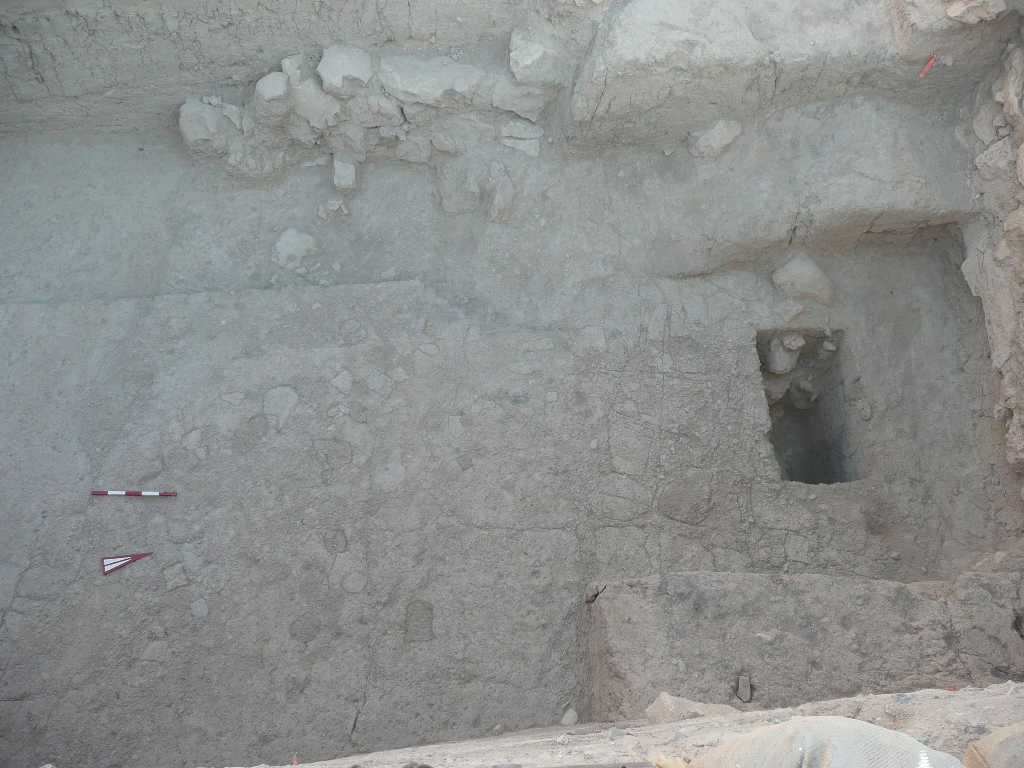
Back to top: Overviw of Unit J1
End of excavation as in 2009
The excavation during this season was reduced and focused most of all on investigating the stones belonging to f288 found at the very end of last season in the small sounding k128. The excavation was carried on mainly in k127 and k129 in order to better understand these structures. The results are very important, mainly for the discovery of the big stone structure ^str1, formed by two bonded stone walls and probably having a function similar to the ED III revetment wall. This allow us to assume the presence of a LC mound or terrace also used during the Ninevite 5 period (as shown by the Ninevite 5 accumulations found last season in k126 and this season in k131), that was replaced by a bigger and more monumental structure in the ED III. This season we excavated two small sounding: k130 to look for the base of the wall and to attempt to have a sure date for it; k131 to check what do we have to the west of the north-south wall f259 and its construction technique. At the very end we also excavated on top of the revetment wall in k132 to make safe this area, uncovering some late structure, probably dating back to the Middle Assyrian period.
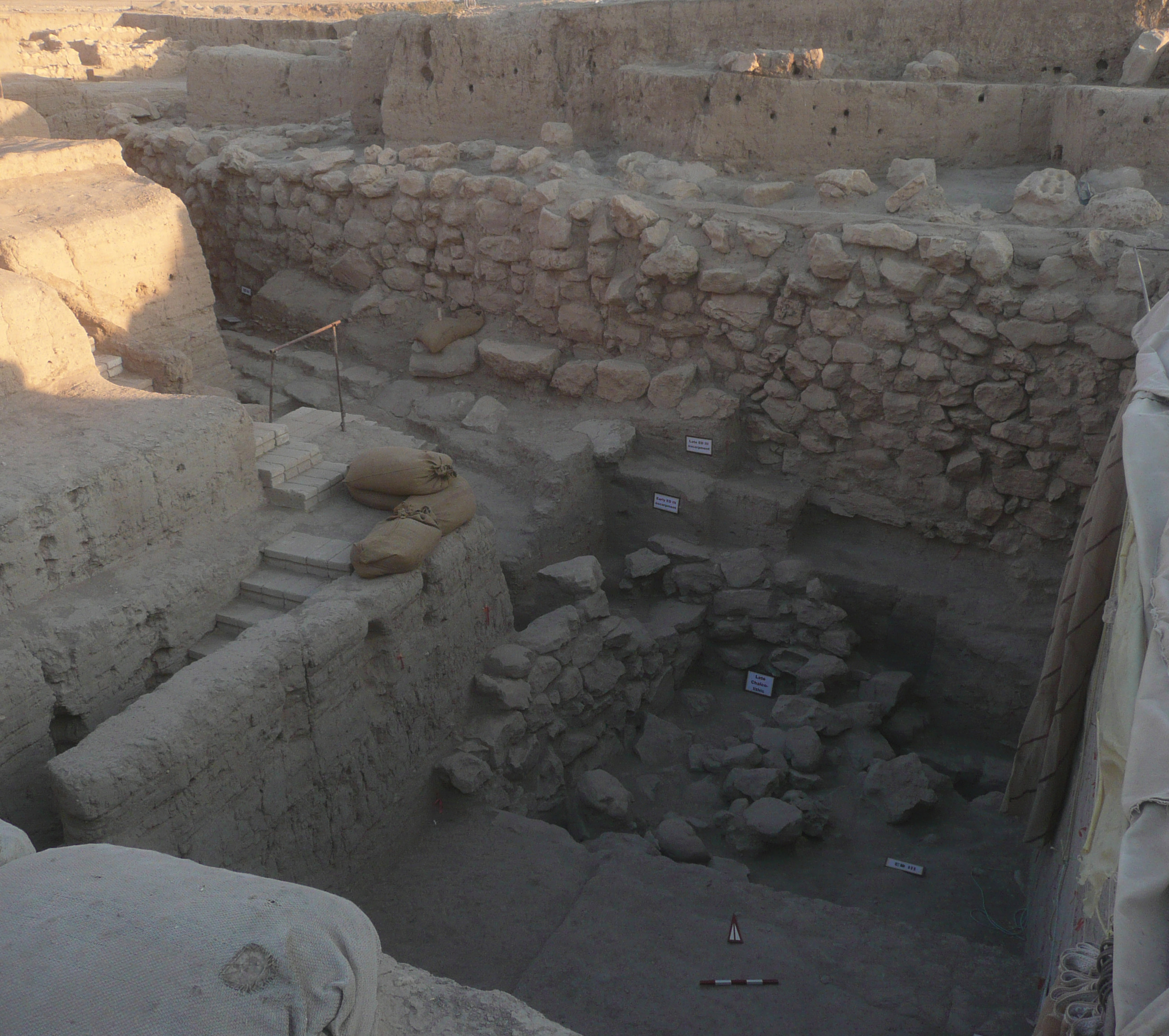
Back to top: Overviw of Unit J1
Goals for the next excavation season
Seen the results from the 2009 season and the impossibility to go to much deeper at the base of the revetment wall, for next season we are planning to excavate in k126 going deeper trying to get a continuous sequence of the Ninevite 5 accumulations able to link the Ninevite 5 period to the ED III, but at the same time to fill up the chronological gap between the Late Chalcolithic and Early Dynastic period. It will be important to see if the sequence is continuous and if not how does it change. It will be important to excavate also to the west to check if the situation (as it seems so far) is different and if there are Late Chalcolithic levels at a much higher elevation. Moreover we have to start to think about the future if it is required to enlarge the excavation area and in this case we should start to plan to start removing the 3 or 4 meters of Mittani accumulation, to the east or more likely to the south.
Back to top: Overviw of Unit J1
Main results
The main results of the six seasons may be summarized as follows.
- The presence of more than 5 meters of Mittani accumulations showing an intensive Mittani occupation at Mozan.
- The non presence of any kind of structure in the plaza that retained its sacral function.
- The identification of diverse types of accumulations abutting the wall, from service related installations near the wall in the earlier period to more sedimentary deposit away from the wall and in later periods.
- The presence of two ED III successive escarpments built with the Revetment wall.
- The great care for this open space (Plaza) during the entire period of use of the terrace complex (cleaning).
- The massive, mainly due to water, erosion that created many problems, already in antiquity.
- The presence of a likely Late Chalcolithic structure linked to a possible late Chalcolithic mound.
- An impressive continuity of meaning and use for this sacral complex.
- The lack of Akkadian and Khabur deposits in this unit, but well attested elsewhere in the high mound.
Back to top: Overviw of Unit J1
General statistics
Excavations
This section was updated May 2016.
| volume excavated | - |
| squares opened | 49 |
| days of excavation | - |
| features exposed | 110 |
| objects registered | 443 |
| pottery lots registered | 1097 |
| sherds analyzed | 45,725 |
Recording
For more details see the section on the data set. This section updated May 2016.
| total number of entries | 341,961 |
| total number of hyperlinks | 1,163,322 |
| total number of photographs | 3,652 |
| total number of drawings | 1,959 |
| total number of output files | 25,482 |
Back to top: Overviw of Unit J1